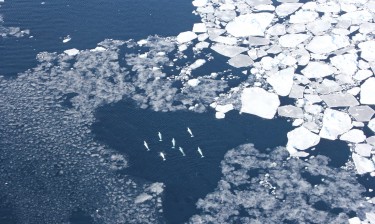
Children’s singer and songwriter Raffi may have brought beluga whales into popular culture with his 1980 song “Baby Beluga,” but surprisingly little is actually known about the life and ecology of these elusive marine mammals that live in some of the world’s most remote, frigid waters.
Two distinct populations spend winters in the Bering Sea, then move north as sea ice melts and open water allows them passage into the Beaufort and Chukchi seas. There they feast on Arctic cod, frequently diving to depths of 200 to 300 meters — and sometimes over 900 meters (0.5 miles) — to find food.
As the Arctic continues to change due to rising temperatures, melting sea ice and human interest in developing oil and shipping routes, it’s important to understand belugas’ baseline behavior, argue the authors of a new paper published this winter in the journal Marine Ecology Progress Series. Its authors drew upon a rare dataset that spans 15 years of dive information for 30 whales to produce a comprehensive analysis of beluga migration and feeding patterns in the Arctic.
“This study gives us a benchmark of the distribution and foraging patterns for these two beluga populations,” said lead author Donna Hauser, a doctoral student in the University of Washington’s School of Aquatic and Fishery Sciences. “However, there still needs to be additional work to see how beluga behavior has changed in concert with changing sea ice conditions in the Arctic.”
Read more at UW Today »
